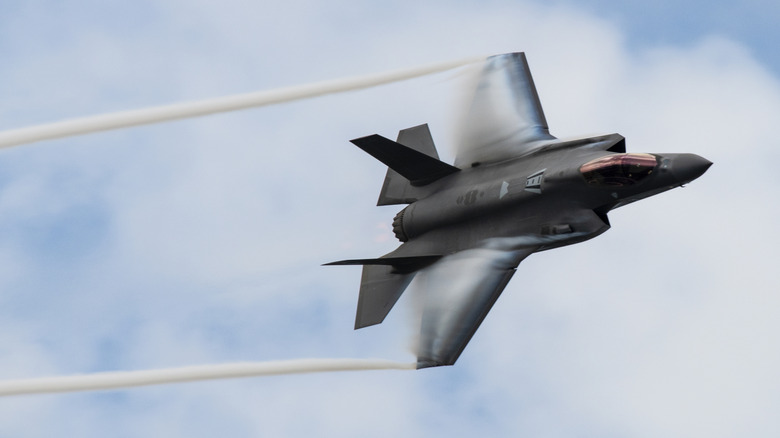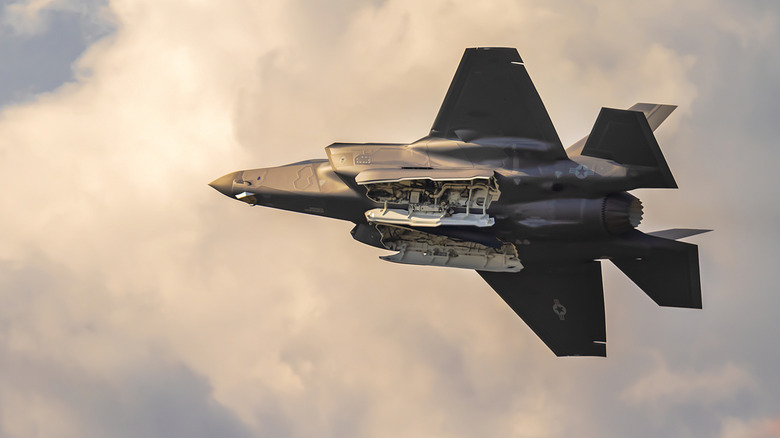Why Trump's Twin-Engine F-55 Fighter Jet Probably Won't Become A Reality
President Donald Trump is no stranger to saying questionable things, and he had some in the U.S. Air Force scratching their heads when he claimed there were plans to develop an F-35 Joint Strike Fighter — or F-55 — with two engines. On May 15, 2025, at a business meeting in Doha with Boeing CEO Kelly Ortberg and GE Aerospace CEO Larry Culp, Trump stated that the two-engine F-35 would be implemented if the price was right.
However, Air Force Secretary Frank Kendall told Breaking Defense that the two-engine F-35 was more than likely not possible. "It's an option that was never presented and that we never considered, to my knowledge," he said. According to Kendall, making an F-35 with two engines would be a complete redesign that would sink the Air Force's budget.
It was also a peculiar strategy when the F-47 Program was just announced. Trump was the one to reveal that Boeing would be producing the sixth-generation fighter jet, with a single unit estimated to cost around $300 million due to its improved capabilities and upgraded tech.
Why is a two-engine F-35 not happening?
During his speech on the future of Air Force aviation, Trump claimed he wasn't a fan of single-engine jet fighters, noting that it's good to have a backup engine (or three) if one goes out. However, experts are not sold on this concept. AeroDynamic Advisory Aerospace Analyst Richard Aboulafia told Breaking Defense that the F-55 is "not feasible" due to the required redesign that would make it the same size and cost as the F-47. A Senior Analyst with the Teal Group, J.J. Gertler, added that this two-engine rework would make the F-35 an entirely new jet since the current design has no room for a second engine.
"The new airframe doesn't just have to be bigger, it has to be stronger to handle double the thrust. Two engines mean a much higher top speed, so you probably have to rethink the wing and tail, and certainly the intakes," Gertler explained. "So saying an F-55 is an upgraded F-35 is like saying a mansion is an upgraded bungalow."
The biggest issue is that Lockheed's F-35 is a stealth jet, meant to be undetected. The larger size and redesign would necessitate numerous calculations to ensure that the two-engine version maintained the same level of stealth, a very complex project to undertake. For now, experts are confident that Trump's statement about a possible two-engine F-35 is not going to impact the Air Force's current plans.
What is the Air Force's current fighter jet plans?
Currently, the Air Force is developing the F-47 with Boeing under the Next-Generation Air Dominance (NGAD) program to succeed the F-35 and other fifth-generation jets. There have been a few roadblocks due to the F-47's incredible costs — the Engineering and Manufacturing Development (EMD) contract will cost $20 billion. However, the U.S. has recognized the need for a sixth-generation fighter jet with advanced technologies as other countries, such as China, continue to unveil advanced jet fighters. In fact, the Pentagon recently delayed the U.S. Navy's next-generation F/A-XX program to prioritize the F-47.
Meanwhile, the Air Force is upgrading F-35 jets while it awaits the arrival of the next-generation fighter — it's still one of the most advanced fighter jets in the world. The focus is on upgrading engine power and adding new capabilities, with Lockheed Martin CEO Jim Taiclet even suggesting a "fifth-gen plus" version of the F-35 to provide 80% of the F-47's capabilities without requiring the purchase of the new fighter jet. There have been no talks of adding a second engine, however.


